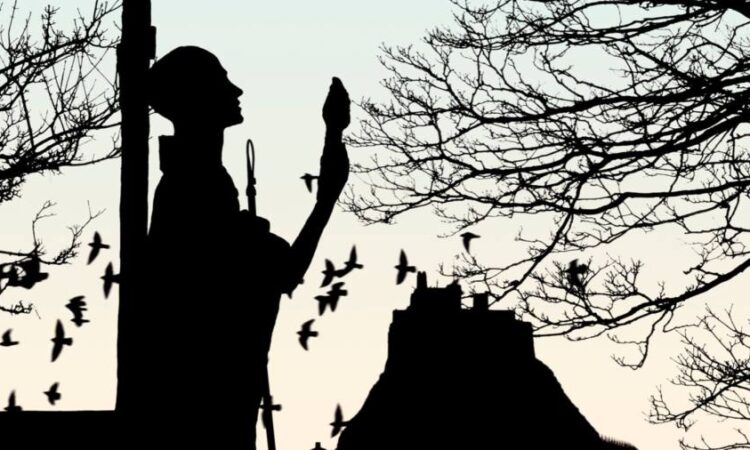
St Cuthbert’s influence over the north of England, and specifically the north-east, is still intact — just like his holy corpse, according to legend. This aura extends from the edge of the sea, at Lindisfarne and the Farne Islands where his remains were exfiltrated during the first Viking raids, to Durham where they ended up, and upon which a cathedral and castle were built: strategically essential for protecting the north during border wars. In nearby cities, many schools are still named after him. I attended one myself, and every morning I and hundreds of other teenagers asked the long-dead hermit to intercede for us.
Benjamin Myers’s latest novel tells the story of the saint and his city from the Dark Ages through to the present day, interweaving the historical, mythological and fictional. Like Durham Cathedral, Cuddy is visionary and imposing, with angular buttresses and vertiginous heights.
We begin in the 10th century with the story of Ediva, an orphan who cooks for the monks who carry Cuthbert’s body as they seek his final resting place. Ediva communes with the dead saint, who tells of his corpse’s journey from Lindisfarne. In “visions” that are revealed to be fits, she imagines an architecture that doesn’t yet exist, dreaming up a cathedral 100 years before building will begin: a “slab of shadows stabbing skywards”.
The timeframe moves on. We see Ediva’s descendants continuing a dialogue with the saint, who — captive to interests far beyond him — watches ordinary people “without judgement”. Among them is Eda Bullard, a 14th-century brewer who falls for a stonemason. In 2019, where we end, a young labourer supporting his terminally ill mother gets work at the cathedral, bringing things full-circle to Cuthbert’s ascetic final days.
It’s tremendously moving, and the arc is a grand one: imagining stories that haven’t made it into the historical record and conferring visibility and respect on those people who would have lived them.
Myers is a creator of loamy, musky pasts, full of gruff humour and acute observation of the natural world. The Gallows Pole, his prizewinning 2017 novel about 18th-century Yorkshire gangsters, is being adapted for television by This is England film-maker Shane Meadows. The finest stories in his 2021 collection Male Tears took us to Hadrian’s Wall during Roman times and even to Neolithic Britain.
Here, Myers’s homely figurative language has an authentic tang of Medievalism. A monk “goes tumbling down the dunes like a turnip off a farmer’s handcart on market day”. One is reminded of Julian of Norwich comparing Christ’s blood to scales scraped from a herring, or, in Piers Plowman, a man with a face like a leek left out in the sun.
This is risk-taking fiction. The text can register on the page like Anglo-Saxon verse, each line organised around periods of stress and alliteration. Ediva’s visions come in fluctuating type settings and font sizes. The writing gradually modernises. As new voices pick up the story, customs change. Memories are lost and resurface.
Myers is a generally excellent stylist who is drawn, here and elsewhere, to mellifluous verbal ornamentation. Sometimes, as deliberate echoes of past literary modes, the results are incantatory: “Afterwards, the stairwell is a funnel of stone down which you pour yourselves, your laughter like liquid, guiding you gaily as you descend back to earth having tasted heaven’s many flavours”.
But features that made Medieval English poetry beautiful don’t always make for beautiful contemporary English prose. “For a few coins she offers a glimpse of heaven to be found in the folds of her flesh or the hot purses of her most private parts”; “The reek of souls suffering sickness is significant”; “they are mindless muscle, hired to dismantle and destroy”. These examples are taken from episodes up to the present day, and are manifestations of a sweet tooth that is found not just in style but sometimes in Myers’s storytelling choices. Yet this sentimentality can also be deeply powerful.
It’s been a while since I’ve reacted as emotionally to a novel. Myers depicts a functional community that is in tribute to a great founding story, but also apart from it and self-sufficient. Something Myers calls “Real living history”. And perhaps it is an epic the north has long deserved: ambitious, dreamy, earthy, dark, welcoming and not; flush with issues. There are readers like me who will not just enjoy this book but feel deeply grateful for its existence.
Cuddy by Benjamin Myers, Bloomsbury £20, 464 pages
Join our online book group on Facebook at FT Books Café







